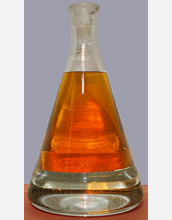All Images
Fact Sheet
What is Green Gasoline?
This material is available primarily for archival purposes. Telephone numbers or other contact information may be out of date; please see current contact information at media contacts.

Green gasoline sits above water in an Erlenmeyer flask. The gasoline and water were the byproducts of a process that converts sugar into hydrocarbons using specialized crystal catalysts called zeolites. The process was developed by Randy Cortright at Virent Energy Systems in Madison, Wisc., with early support from NSF's Small Business Technology Transfer program. Other approaches to develop green gasoline have been developed by George Huber at the University of Massachusetts Amherst and James Dumesic of the University of Wisconsin, Madison (once the research advisor for both Huber and Cortright). Huber's process can start with wood, waste paper, or any other cellulose source to create components of high octane gasoline. The process that begins with sugar, also under study by Dumesic, can create the full suite of gasoline components and is capable of creating diesel and jet fuel in addition to precursors for pharmaceuticals and plastics.
Credit: Virent Energy Systems, Inc. Contact Virent for image permissions and use.
Download the high-resolution JPG version of the image. (125 KB)
Use your mouse to right-click (Mac users may need to Ctrl-click) the link above and choose the option that will save the file or target to your computer.


